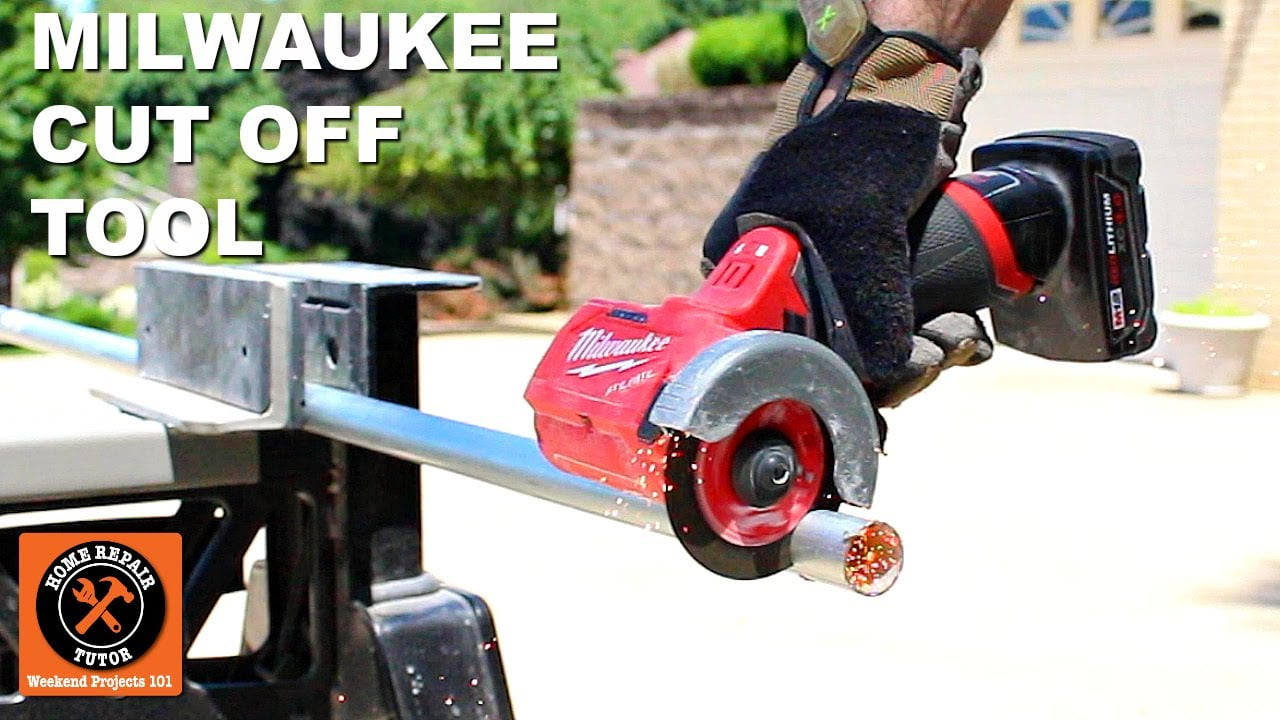
This post may contain affiliate links which means I may receive a commission for purchases made through links. Learn more on my Private Policy page.
All right, guys. Today we’re going to be
taking a look at Milwaukee’s 3” Compact Cut Off Tool Kit. Now, I really like these
kind of tools because they’re multidimensional, meaning you can cut a variety of different
things, and that’s always really helpful when you’re on a project. So, let’s open
up the box; take a look and see what’s inside. The model number on this is 2522-21XC. So
in case you’re interested, that’s the number you need to look for at the store.
Milwaukee did send us this cut off tool, but we do not do paid reviews, and that’s important
for you to know. Let’s open up the box. While we’re doing
that, I did want to mention that this is a brushless motor.
So right off the bat, you can see this kit comes with a bag, which is always nice.
As
I’ve mentioned before, I love Milwaukee’s bags; they’re nice and sturdy. You get three
different types of cut off wheels; we’ll go over these one by one. This is the M12
charger. This is kind of neat. This is a dust extraction system. They’re becoming more
popular because of OSHA regulations. But it’s obviously a very nice safety feature as well.
This is the M12 RedLink XC 4.0 Ah battery. So this is what you need to use with this
cut off tool. And then finally, this is the tool itself.
As you can see, it’s nice because
you can just hold it with one hand. It’s very petite, for lack of a better word. And
I’m really excited to test this out and show you what it can and cannot do.
One of the things I’m a little bit bummed about with this battery is there’s no power
indicator on it. Typically, with Milwaukee batteries there’s a power indicator on the
front. For example, this is a 5.0 Ah battery. And if you press the button here, you can
see how much power you have left. That’s really, really important. Unfortunately, it’s
not on this XC 4.0 Ah battery. So, little bit of like eh… wish that was there.
On the cut off tool itself, it has a wheel guard, which is great. And from what I can
tell, the wheel guard is not removable. So on a typical, for example, angle grinder,
you can remove this; although, we leave ours on. There’s a forward and reverse button
here on the side. There’s also a white indicator on the top of the tool that shows whether
or not it’s in forward, neutral, or the reverse position.
I’ve never seen that before,
but it’s kind of a rudimentary way of showing that.
The lock out button is in the front of the tool. So you have to press this and then turn
the spindle until it engages. That way you’ll be able to swap out or install one of the
blades. The trigger’s on the bottom of the tool.
And what I like about this is it’s very ergonomically easy to use.
Now, Milwaukee gives you three types of wheels with this kit. You have a diamond blade for
cutting tile. You also get a metal cut off wheel—and these are all 3” by the way.
And then you get an abrasive wheel that’s meant for cutting a variety of different materials—actually,
let me take a look. This is for drywall, fiber cement board, and plastic. And we’re going
to test all three of these wheels on different types of materials. So don’t worry; we’re
going to get around to that. Now, here’s the deal. The maximum rpm for
this tool is 20,000. Now that’s quite a bit because most angle grinders in fact are
only like 11 or 12 or 13 thousand; really just depends on your angle grinder.
So 20,000
rpms? That’s pretty impressive for this little tool. The other thing to remember is
this can accommodate both 3/8 of an inch and 7/16 of an inch arbor size. And they give
you an adaptor here that you can put onto the tool for a 7/16-inch arbor.
So we’re going to put the first blade onto this. And what we need to do is use the Allen
wrench that they give to you. So there’s a bolt. Actually, you want to turn this clockwise.
There’s a top flange.
And then there’s a bottom flange. You can leave the bottom
flange on. Now, the most important thing is to install these blades the right way. They
have arrows on them that indicate the direction in which you need to put the blade onto the
tool. Now, because we’re only going to be using
this diamond blade in the forward direction, we’re going to be lining up the arrow on
the blade with the forward direction arrow. So it’s really as simple as installing it
like that. So you want this to snap into place over top of the spindle. And you want to put
your top flange on, and then this bolt.
And to tighten this bolt, we’re going to turn
it counter-clockwise. And we’re just going to tighten it until it’s nice and snug.
And by the way, it’s a best practice to not have the battery in the tool while you’re
putting the cut off wheel in place. So, one of the biggest questions I had was,
“How do you put the dust shoe assembly on this little, tiny tool?” Well, I’m going
to show you. Inside the dust show assembly, there’s a
little, red tab. This sticks out. When the dust shoe assembly is installed correctly,
that little red tab engages with the slot in this wheel guard. So really the first step
is to understand the orientation of the dust shoe assembly, and this is how it should look.
You should have the port facing the front of the tool. And then the tool needs to slide
into the dust shoe assembly.
And you want to slide the tool backwards so that that little
slot in the wheel guard is engaged by that red tab. There really isn’t much to it,
and you won’t feel a lot of movement. You’ll just feel a subtle engagement of that tab.
So, that’s really all there is to it. And now that it’s engaged, you’re good to
go. Now, if you want to remove this dust shoe assembly, you press down on the red tab here.
And what that does is pulls that red tab inward, and then you can disengage the wheel guard
from the dust shoe assembly.
But for now, we’re just going to reengage that because
we want to use the dust shoe assembly. Overall, it’s a pretty slick assembly. And
once you do it a few times, it becomes pretty easy to take the dust shoe on and off.
One of the things that I forgot to just mention though is you want to have the depth of cut
at its maximum distance to install the dust shoe assembly onto the tool. So really, there’s
just a wingnut back here. You loosen it, and you can move this depth of cut up and down.
The other great thing is there are increments on the back of this depth of cut, and those
align with the arrow on the side here. So you can easily adjust your depth of cut depending
on the type of material that you’re using.
So for example, if you’re cutting ¼-inch
thick tile, you can just simply loosen this nut and adjust the depth of cut to just a
little bit more than a quarter of an inch. But the nice thing is that this is easily
adjustable, and you can put it anywhere you want, up to looks to be like about ¾ of an
inch. So there you go. That’s how you adjust the depth of cut. And that’s really nice
to have when you’re cutting tile. We’re going to start making cuts on the
porcelain and ceramic tile. But before we do that, always make sure you have your safety
gear.
So hearing protection, safety glasses, gloves, and if you’re not going to be using
the dust shoe, then get yourself a silica dust respirator. We really like these ones
by Sundstrom. They’re awesome. They don’t do so well for those of us with facial hair,
but definitely worth the $50. The first test that we’re going to do with
the cut off tool and that diamond blade is on a 12×12 inch piece of 3/8-inch porcelain
tile. This is a very, very hard tile. We’re just going to make a straight cut through
it and see how it does. And by the way, we are going to have this
hooked up to a Shop-Vac while we’re doing the cutting.
The battery installation is very easy. Just simply push it in until you hear the click,
and you’re good to go.
So this is a ¼-inch Shop-Vac hose that we
connected to the port here. So it’s in there pretty snug. If I had my druthers, I’d put
some type of Fernco system on this to keep it nice and secure. But it is pretty tight,
and it is on a swivel. So we’ll see how it performs as is.
I’m personally obsessed with electronic brakes. Check out this one. Not too shabby,
right? So that’s a really nice safety feature. We’re just going to be using a very affordable
Shop-Vac on this. Obviously, you can get an expensive HEPA Vac, too, which we love. But
we’re going to use this 3.0 horsepower Shop-Vac. So this first cut is just a straight cut through
the 3/8-inch porcelain. And as you can see here, there’s still a lot of dust shooting
out from the cut off tool. That’s mostly a function of the Shop-Vac. It was a little
bit of a struggle to cut through this porcelain, and one of the things I’d like to highlight
is the fact that the blade may need to be worn in.

But in this particular case, it was
a little bit more difficult to cut through than it would be with a traditional angle
grinder. As you can see here, we struggled until the end to make that cut. So it just
took a little bit longer than I anticipated. Here’s my first impression cutting through
this porcelain: the tool seems like it has a lot of power, but the electronics shut it
down whenever it starts to overheat or whenever it starts to really become pressured by the
load that it needs to cut through the tile. So in terms of long cuts, I’m not so sure
about that. But now, here’s the deal: this is just a 3-inch blade too. Typically, when
we cut through tiles, those blades are a minimum of 4 ½ inches.
So where a 3-inch blade comes
in handy though is cutting through tile for electrical outlets. So let’s see how this
cut off tool works for that. The other thing I wanted to mention, as you
probably saw, this Shop-Vac didn’t do the best at extracting all that dust. Definitely
try to use a HEPA Vac for that. With a traditional angle grinder, it’s a
little bit difficult to cut out a typical electrical box just because of the size of
a 4 ½-inch angle grinder blade. The 3-inch blade for this cut off tool is perfect for
this type of project. And as you can see here, we’re working our way through the cut of
this porcelain tile.
It’s pretty easy to cut through it. And definitely, I highly recommend
the cut off tool for this type of project. The blade could handle the porcelain in short
cuts and short bursts. It’s just that whenever it’s a straight, long cut, I feel like the
cut off tool and the blade struggle a little bit. But in this particular case, I love the
3-inch blade and the fact that you can complete the cut on the back side of the tile.
As you saw, it was pretty easy to cut out the dimension for the electrical box. There
are a few different problems here. The blade is not that great that Milwaukee supplies.
As you can see, there’s chipping in this porcelain along the edge here. Not too much
of an issue with an electrical outlet because the cover will hide that. But the other issue
with this cut off tool is the small wheel guard here.
On a traditional 4 ½-inch angle
grinder, the wheel guard is much more substantial because it’s 4 ½-inch blade. This is very
tiny, and I highly recommend that you wear at least some type of eye protection, if not
full face protection, because I was getting shot at by a bunch of different pieces of
porcelain, slivers of porcelain. So be very, very careful if you’re cutting porcelain
or ceramic with this. It will cut through it. Does it make a perfect cut with the blade
Milwaukee provides? Absolutely not. I think that one of the biggest recommendations I
have for Milwaukee is to come out with different types of blades that work a lot better with
porcelain and ceramic. The next test is going to be with a carbide
abrasive wheel. This is a little, tiny beast, and it’s used for cutting through drywall,
fiber cement board, and plastic—so things like ABS and PVC.
So remember how at the beginning of the video I said I was upset about the battery indicator?
Well, it’s actually on the tool.
So you got to press the trigger, and that lights
up the battery indicator right here. So kudos to Milwaukee for putting the battery indicator
on the tool even though it’s not on the battery.
So this is a test that we’re going to be doing to just cut out a little electrical
outlet spot in a piece of cement board. In this case, this is Durock. And it has a waterproofing
liquid membrane over top of it. So that’s just to add a little bit more complexity to
the test. So let’s cut this out. So we started the cut on the top surface with
the liquid waterproofing membrane. By the way, this is Ardex 8+9, so it’s a pretty
heavy duty liquid membrane. But as you can see here, the cut off tool and the cut off
wheel do a really great job of cutting right through the surface of this.
It does create
dust, no doubt. So if you can put the dust shroud onto the tool, that’s best. And I
would highly recommend that you do that if you have to make a lot of cuts through cement
board. But obviously you don’t necessarily need this tool to cut through cement board;
it’s just something that’s going to speed up that process. Nonetheless, it really did
very, very well with this CBU. I got to say I’m impressed with the cut
off wheel and the tool cutting through this cement board.
No problem whatsoever. So, what’s
going to be our next test? Let’s cut through a piece of PVC because oftentimes when you’re
demoing things, you just want to be able to cut through the PVC or if you just need a
short piece of pipe. So, we’re going to grab PVC and do that test.
By the way, that was a ½-inch piece of cement board, and this is a 2-inch piece of PVC.
So we’re going to cut through this. As you could see here, we’re cutting right
through the 2-inch piece of PVC.
No problem whatsoever. This is a no-brainer, but make
sure you hold onto the pipe nice and tight if you’re in a situation like this one here.
If you’re just going to be demoing, then obviously you got to make sure that the pipe
is secured and you can make a nice, clean cut, and you can bond another piece of PVC.
I felt that this cut off tool did a really nice job of cutting through. And you can actually
clean off the cut, too, fairly easily. So if you need to square that off, not a problem
whatsoever. This is another angle of a cut. So this one’s
sped up, obviously. But as you can see here, the tool doesn’t have any issues cutting
through PVC, and I really liked how it performed. So no problem cutting through the plastic.
The only issue is, unlike with Sawzalls, you can’t go right though the entire thing.
You have to rotate the pipe. But nonetheless, it’s a great cut off tool for that. So the
next test is going to be on a variety of different types of non-ferrous metals.
So we’re going
to be cutting through copper, some conduit, and a U-channel that we used for putting in
glass doors and glass panels. We’re going to put the metal cut off blade onto the cut
off tool for these tests. Metal test number one: 1-inch type L copper.
Overall, it did cut very well through the copper. I’d love to know what your thoughts
are, though, so let us know in the comments. Oh, and before I forget, the unfortunate thing
about the kit is it only comes with one battery. So I’d love to see Milwaukee come out with
a kit that has two batteries, and maybe there is one, I just don’t know about it.
But
only having one battery with the tool is really, really tough, especially because I have a
bunch of different Milwaukee tools, but I don’t have that 4.0 Ah XC battery that is
needed for the cut off tool. So, got to wait for it to charge.
So this is conduit. And as you can see here, it doesn’t take long for the cut off tool
to go right through it. And I think this is a testament not only to the power of the tool
but also the blade that comes along with it. Okay, that was pretty fast. It’s definitely
no problem cutting through the conduit. Now, the last test that I want to do is on a piece
of U-channel. This is the U-channel that we used to put in glass doors and glass panels
for showers. So let’s see how the cut off tool does for that.
I would highly recommend using this cut off tool for a U-channel because it made a clean
cut. All you have to do is make it look a little bit nicer using a file.
But you’d
have to do that anyway if you cut this on a miter saw.
Okay, so what are the final thoughts for this tool? Where do you get it? And what is the
price? The final thought is this. If you’re just
doing electrical outlet cuts and porcelain or ceramic tile, this is a great tool for
that. If you need to make longer cuts, I would say it’s not really quote where I would
want it to be. And I highly recommend Milwaukee come out with different blades for this because
trying to find a 3-inch blade for a cut off tool is really, really difficult.
What about cutting through things like metal and conduit and plastic? Well, this cut off
tool excels at that.
So if you’re going to be using it for those purposes, I highly
recommend it. Now, what is the cost, and where do you find
it? It’s about $130 for the tool only. About $199 for the kit that we just reviewed in
this video. So it’s definitely not a cheap tool, but it’s very solid. Twenty thousand
rpms. Plenty of power. You just need to know that it does have limitations with the 3-inch
blade. And definitely wear your safety gear when you’re using it, especially with tile.
Let us know what your thoughts are on this down in the comments. We’re always open
to different tips and tricks on how to use these tools. So if you have one and you’ve
used it, let us know what your thoughts are down in the comments section.
Thanks for watching this video, and we’ll see you in the next one..
This post may contain affiliate links which means I may receive a commission for purchases made through links. Learn more on my Private Policy page.






